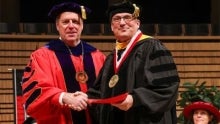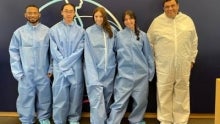Rensselaer Polytechnic Institute Nanotechnology Expert Nikhil Koratkar Named American Physical Society Fellow
Nikhil Koratkar, Ph.D., John A. Clark and Edward T. Crossan Professor of Engineering at Rensselaer Polytechnic Institute, has been named a fellow of the American Physical Society (APS). Koratkar was recognized for his pioneering contributions to the field of nanoscale science and technology and the use of nanoscale materials in composites and energy storage devices. Each year, no more than 0.05% of the society membership is recognized by their peers for election to the status of fellow of the American Physical Society.
With New Grant, RPI Works To Shrink Microchips, Expand Semiconductor Workforce
Transistors — the tiny on-off switches inside microchips — have gotten smaller and smaller over the years, increasing computing power and enabling smaller devices. During that time, the copper wires that connect these switches have likewise shrunk.
However, smaller, thinner wires create a big problem, said Daniel Gall, professor of materials science and engineering at Rensselaer Polytechnic Institute.
Job opening: Tenure-Track or Tenured Faculty Position in MSE
Posted November 6, 2023
The Department of Materials Science and Engineering (MSE) at Rensselaer Polytechnic Institute in Troy, NY, invites applications for a tenure-track Assistant or tenured Associate Professor position in Materials Science and Engineering with expertise and potential in the broad area of bulk/thin film metallic materials.
Researchers Use AI To Predict Challenging Behaviors Common in Profound Autism
Using artificial intelligence tools to analyze years of biomedical data, researchers at Rensselaer Polytechnic Institute have discovered a possible connection between sleep, gastrointestinal health, and two potentially harmful behaviors often associated with profound autism: self-injury and aggression. Their study is published in the Journal of Personalized Medicine.
RPI Alumnus Featured in Discovery Network’s “Veteran’s Playbook”
U.S. Army Veteran and RPI alumnus Daryian Rhysing, who graduated in 2016 with a degree in computer and systems engineering, was featured in an episode of Veteran’s Playbook airing on Discovery Network’s Destination America Channel. The show seeks to inspire active military and veterans to consider business ownership as a viable path to success and fulfillment.
RPI Alumnus Sheldon Weinbaum ’59 Named Recipient of National Medal of Science
Rensselaer Polytechnic Institute has announced that President Joe Biden has bestowed the National Medal of Science on globally recognized biomechanical engineer Sheldon Weinbaum, a member of the RPI Class of 1959. The award is the highest honor for scientific achievement bestowed by the United States government. The award recognizes individuals deserving of special recognition for their outstanding cumulative contributions to knowledge in the physical, biological, mathematical, engineering, or behavioral or social sciences, in service to the nation.
The Future of AI Is Wide, Deep, and Large
ChatGPT has fascinated the public as we begin to explore how generative artificial intelligence (AI) can be useful in our everyday lives. On the back end, scientists are continually advancing AI for potential applications so vast that it may change life as we know it by accelerating scientific and technological developments.
Rensselaer Students Win National Competition for Heart Monitoring Device Design
This past summer, a team of Rensselaer Polytechnic Institute students, with the guidance of a faculty mentor, pitched a winning design for a wearable, medical-grade device that monitors for atrial fibrillation. Atrial fibrillation, or A-fib, is a potentially life-threatening heart condition that will affect an estimated 12 million people in the U.S. by 2030, according to the Centers for Disease Control and Prevention.









